It’s an oft repeated phrase that children are frequently difficult to see in the historical record. Other than records of births, deaths and unfortunate accidents, children – that is, the lives of individual children, named and known – are far more scarcely represented than their grown-up counterparts. The antics of children, seen through the lens of an adult perspective, unsurprisingly, are there in the newspapers, in diaries, letters and books, but these stories are at best generalisations and at worst exaggerations.
This is not to say that the lives of children are completely unknown to nineteenth century New Zealand history – I’ve got a great book about the history of child’s play in New Zealand (Sutton Smith 1981), for example – but that, unlike so many of the people we encounter in the archaeological record, who have names and faces and stories, children usually remain – at best – a name and a date of birth. Similar to the treatment of women in some parts of the historical record, they are often considered an extension of the adults (usually men) to whose stories they belong until they are old enough to be known for themselves.

Cora Villa, the subject of the exhibition that’s just finished at South Library, is therefore all the more fascinating for the material and documentary evidence it provides for the lives of the children who were born or sheltered within its walls and who, I like to think (perhaps romanticising a little) ran through its rooms and played in its garden. At least five children were born at the house between 1878 and 1900. At least another three lived there in the early 1900s and it’s entirely possible that more children came and went with their parents in the intervening years. Some of their names and stories remain known, and some do not. Charles and Agnes Marshall welcomed three children during their time at the house, between 1885 and 1893: James, Agnes and Kuini Mei. James and Agnes are not particularly easy to trace (too many people of the same name!), but Kuini Mei passed her Junior Civil Service exams in 1907 and went on to become an accountant, passing University of New Zealand exams in “auditing and trustees, bankruptcy, and companies” in 1913. All three, the children of Scottish immigrants, also make frequent appearances in Caledonian Society events along with their parents (there is nothing at all embarrassing in these accounts, but it still makes me exceedingly grateful that no-one will ever be able to read similar records of things I attended as a kid…).
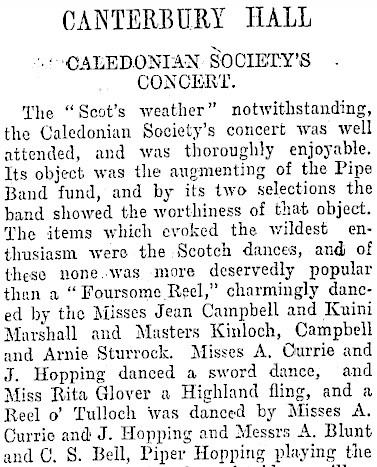
It is likely that at least some of the many children’s artefacts found underneath Cora Villa belonged to the Marshall children. Several children’s cups (or cans, as they are known) from the assemblage were likely made by the Brownhills Pottery Company between 1872 and 1896 (Maryland Archaeological Conservation Lab 2012; Riley 1991). A couple of the designs were first registered in the 1883 and 1885 and it seems quite likely that they could have belonged to James (b. 1885), Agnes (b. 1887) and Kuini (b. 1891) before they were abandoned under the house.
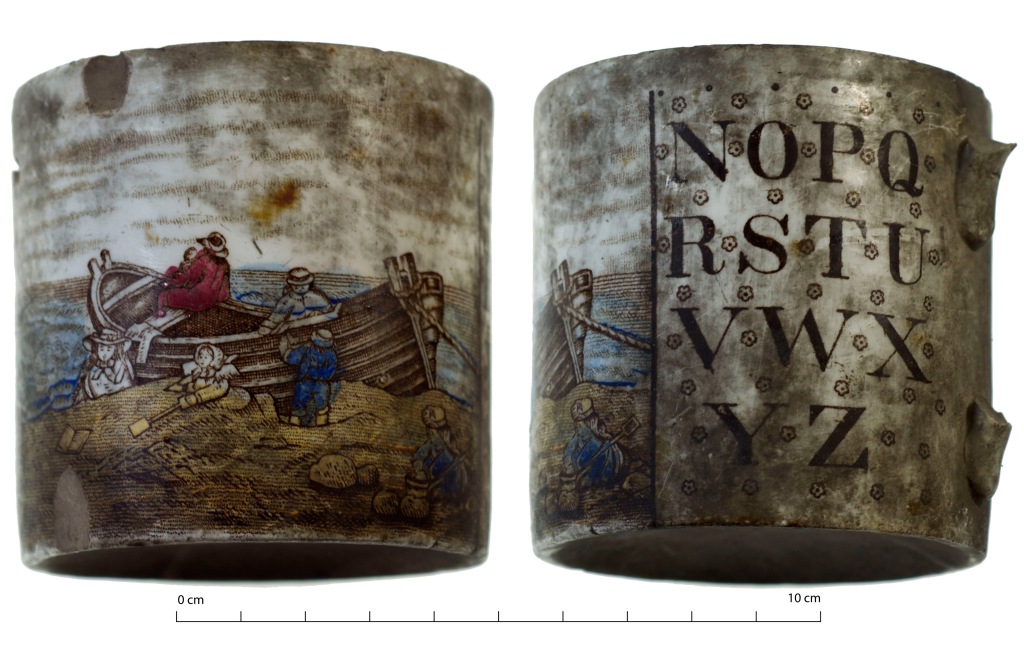
Nineteenth century children’s crockery often featured designs from well-known stories, morals or publications on their surfaces, sometimes accompanied by blocky, coloured alphabet motifs (entirely predictably, these are known to collectors as ABC plates). The scenes depicted on cups and plates could sometimes be simple and colourful, showcasing typical aspects of childhood, or lean towards more educational and morally specific depictions at the ‘moralising china’ end of the spectrum. The array of children’s cups from Cora Villa include both, from a colourful ABC cup depicting a family boating at the beach (including what looks like a baby with really long arms buried in a sand dune?) to a cup decorated with a maxim from Benjamin Franklin’s alter ego Poor Richard. There’s a cup with the title “DUBLIN”, beneath which the River Liffey trudges past the Dublin Custom House and the old Butt Bridge (tried hard not to laugh at this, failed, I am terrible), and my personal favourite, a cup where the title “LETTER” does not at all adequately describe the scene of two people who have apparently decided to post letters to each other through the medium of a tree, rather than the postal service.
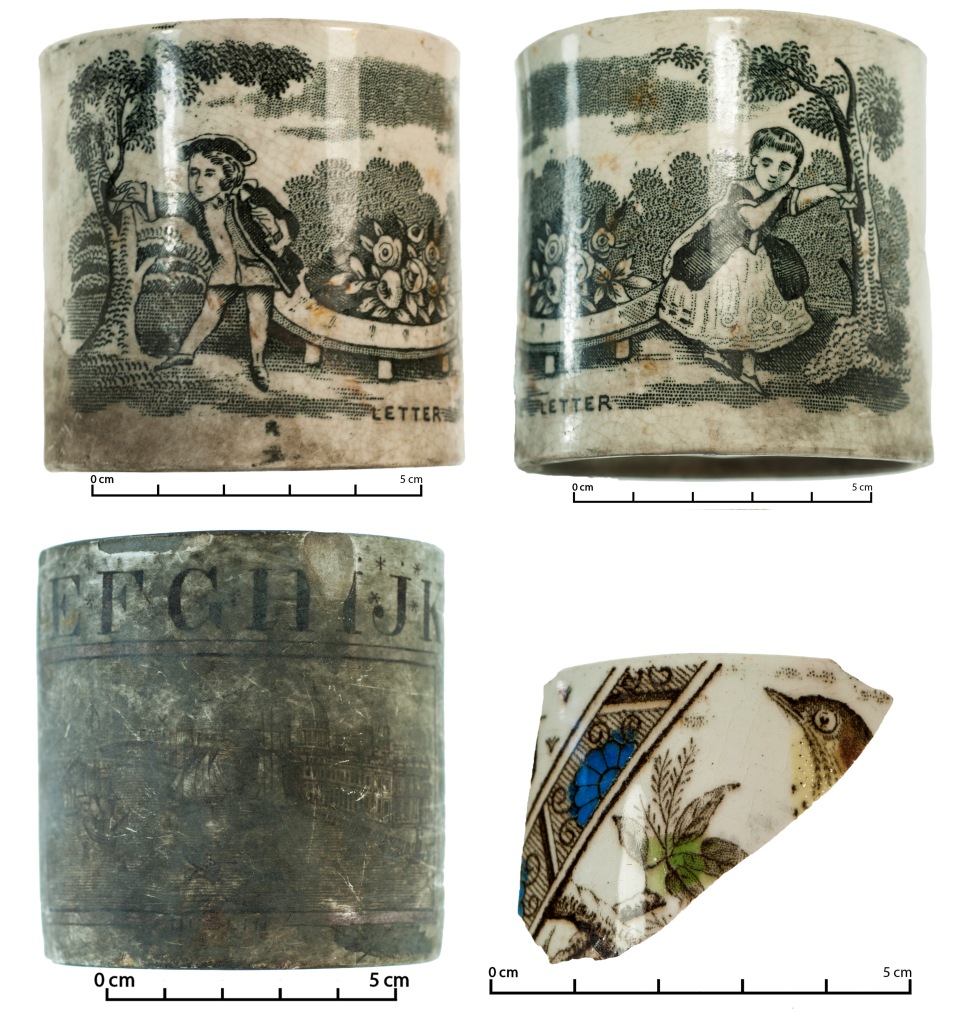
The Benjamin Franklin/Poor Richard cup is particularly interesting. Poor Richard’s Almanack was written and published by Benjamin Franklin in the late eighteenth century and became well-known for the wealth of proverbs and axioms it provided, especially to those in the nineteenth century (Riley 1991). This particular cup, which features several men (one of whom, shockingly, does not appear to be wearing any pants – poor shading, that) hard at work with spades and pick-axes, would have originally read: “Handle your tools without mittens, remember the cat in gloves catches no mice; Constant dropping wears away stones and little strokes fell great oaks” under the title “THE WAY TO WEALTH OR DR FRANKLIN’S POOR RICHARD ILLUSTRATED, BEING LESSONS FOR YOUTH ON INDUSTRY, TEMPERANCE, FRUGALITY”. The patience and perseverance moral of the second adage seems fairly obvious, especially with the image of men (pantsless or not) chipping away at the earth, but there’s a part of me that really wishes the illustrator had instead gone with an image of a cat chasing mice while wearing gloves.
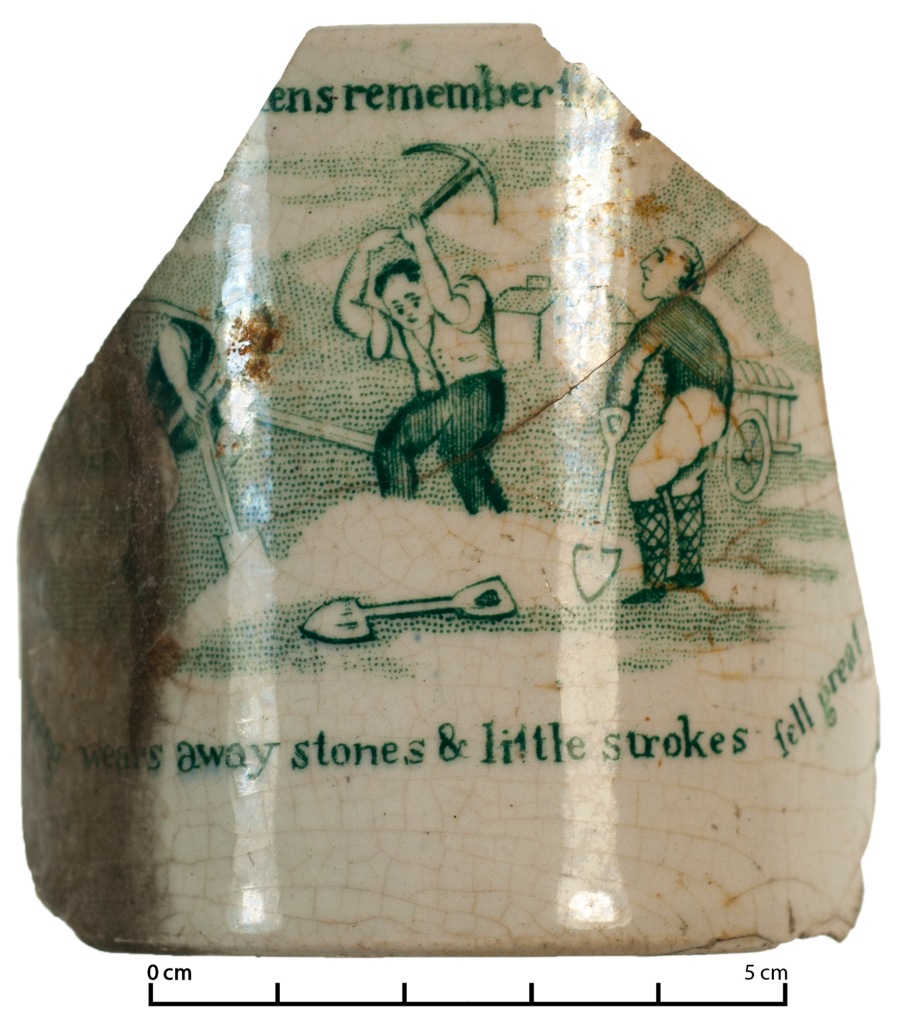
Moralising china says something about Victorian society, about manufacturing and marketing choices, but also about the values of parents – particularly because there’s an assumption that people will police their consumer choices more when their children are involved. I’d love to draw a connection between the Scottish heritage of the Marshall family, the stereotype of the staunchly moral Scots family in New Zealand, and the hardworking, persevering values of this cup, but I think it’s a bit of a stretch – it’s far more likely that the fairly standard values of hard-work and patience appealed to them, as I’m sure they did to many other nineteenth century families.
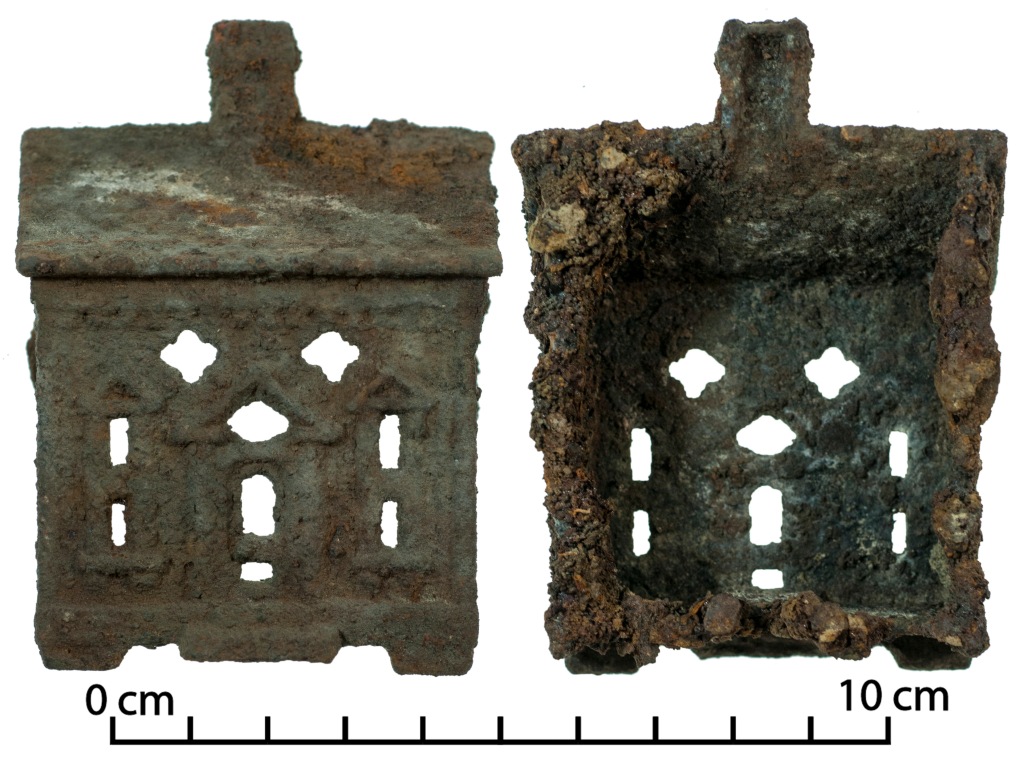
Other children’s artefacts from the underfloor assemblage shift us away from the educational and practical aspects of children’s lives, to play. In particular, a hand-carved toy boat was found in one corner of the house and it is not hard to picture the tiny humans of the house – be they the Marshall children, or the children of later tenants (the Bradbury family, the Goodwill family, the Elstob family) – playing with it in the shallows of the nearby Avon River. It may have been used in races, endless hours of fun created from the natural current of the river and a hollowed-out piece of wood, before it was outgrown or lost under the house.

Unfortunately, not all the stories of the children of Cora Villa were good ones. The children of the Elstob family lost their mother there in tragic circumstances in 1910, and there is something inherently sad by association in the early 20th century children’s artefacts from the assemblage that may have belonged to them – a cup decorated with the faded print of children skipping rope, the fragment of a possible christening cup. What did these objects mean, to those children, at that time?
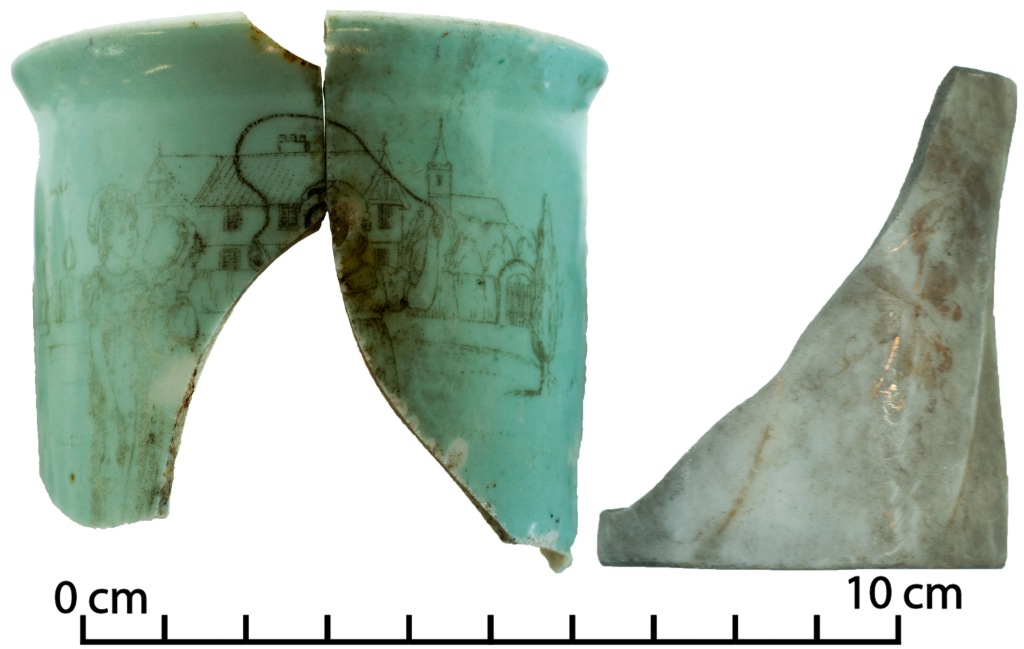
While I do not think I would have liked to be a Victorian child, especially a Victorian girl-child (much too contrary, full of opinions and FAR too fond of climbing trees!), these toys and plates do feel familiar in a way that I suspect children’s toys always will, no matter where or when they come from. I go on a lot (here and everywhere, sorry everyone who knows me) about artefacts as things of meaning, objects that mean more than their physical manifestation and I think this is true of children’s artefacts more obviously than most. Toys and cups and favourite things mean so much when you’re a kid – they’re the difference between a crying child and a smiling one, a child who will sleep and one that won’t. They bring comfort, joy, safety, familiarity and I don’t know what else – I imagine most of us can remember an object we loved as children, that meant so much more than it should have. In turn, as adults, those artefacts carry a nostalgia with them, a physical reminder of our own childhoods, or of the notion of ‘childhood’ in general, sentiment that makes them more than just an unusually decorated small drinking vessel or a miniature version of a boat. They’re evocative, and these particular children’s artefacts evoke for me the lives of the children who lived in Cora Villa over a century ago. They breathe life into the names in the newspapers, children made somehow more real through the old toys I hold in my hands.
Jessie
References
Barshter, N., and Chappell, B., n.d. Brownhills Pottery Alphabet (ABC) ware Birds. [online]. Available at: http://www.oldchinaservice.com/transferware/brownaesthetic/aaestheticindex.html [Accessed November 2014].
Maryland Archaeological Conservation Lab, 2012. Alphabet Wares. [online] Available at:
http://www.jefpat.org/diagnostic. [Accessed November 2014].
Mitchell, P., Geary Nichol, R. and Jackson, G., 2015. 396 Oxford Terrace, Christchurch. Report on Archaeological Monitoring. Unpublished report for CERA.
Riley, N ., 1991. Gifts for Good Children: The history of children’s china 1790-1890. Richard Dennis, England.
Sutton Smith, B., 1981. A History of Children’s Play: The New Zealand Playground, 1840-1950. University of Pennsylvania Press, Pennsylvania.
